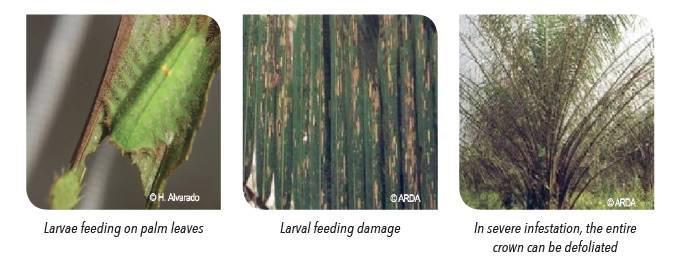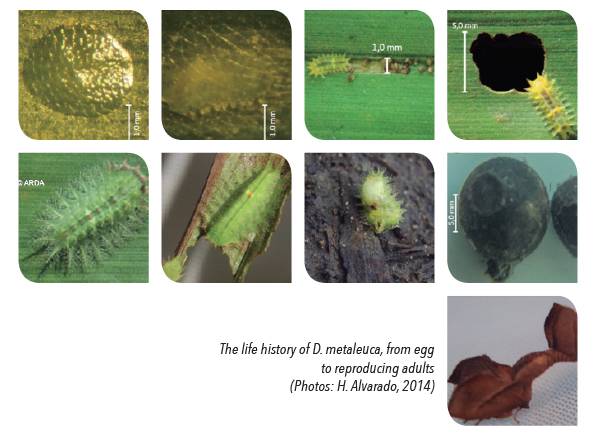General Information

The larvae or caterpillar of Darna metaleuca causes severe defoliation on oil palm. The caterpillars usually feed on the underside of leaves. The young caterpillars often strip the leaf surface to feed, while the older caterpillars eat away the whole leaf, leaving only the midrib. The entire crown of the palm may be defoliated during severe outbreaks. Severe defoliation, particularly of the young leaves, may affect the yield of fresh fruit bunches (FFB) and oil yield.
It is a major pest of oil palms in Latin America. The larvae can can consume between 50 and 75 cm2 leaf area on average during their lifetime. An entire colony can cause up to 80% defoliation. In Colombia, E. eleasa has been observed in localised attacks on oil palm plantations, reaching critical levels between 50 to 80 larvae/sheet.
In addition to palm damage, D. metaleuca also pose health risks to infested areas. The caterpillars have stinging spines that can cause painful injury to plantation and nursery workers, and irritation (or allergies to sensitive individuals).
Distribution
Brazil, Colombia, Ecuador, Guatemala, Guyana, Honduras, Mexico, Panama, Peru, Suriname, Trinidad and Tobago and Venezuela
Detection and Inspection
ADULT MOTHS
Male and female look alike. Both are brass in color with a line running down centrally through the front wing. Up to 23 mm in size.
COCOON
The brown cocoon is a hard, nearly spherical case. It measures 7.4 x 6.0 mm and in formed near the midrib of the leaflet.
LARVAE
The young larvae, I instar, are less than 1.0 mm; pale yellow with simple tubercles. The II instar is 1.2 mm long; bristles start to emerge from the tubercles. The III instar changes slightly in coloration turning greenish, and develops small brown and yellow spots on the back that will persist until the VI instar. The size of the III instar measures about 3.4 m and the size of the VI instar is 10.5 mm.
EGGS
Deposited on the undersides of leaves, either in a row or singly. The eggs are flattened, translucent, and turn yellow as the embryo develops. Eggs are elliptical and measures, on average, 2.0 mm long and 1.5 mm wide.
Prevention and Control
PHYTOSANITARY
Eggs and young larvae are difficult to detect via visual inspection. Only the larger mature larvae or adult moths are more likely to be detected. Cocoons may be contaminant in seed lots. Therefore, ensure source of germplasm from pest free areas. Proper sanitation from sourcing to shipping is crucial. The import of germplasm material (seeds, pollen, tissue culture) must be accompanied by an import permit issued by or on behalf of the Director-General of Agriculture for Peninsular Malaysia (including Labuan), or the Director of Agriculture for Sabah, and a phytosanitary certificate issued by an authorised official from the country of export. The import conditions are available upon request from the Plant Biosecurity Division Malaysia. All consignments are subjected to inspection by the Agricultural Department prior to clearance by Customs. Germplasm material imported from high risk areas should be sent for third country quarantine before arrival onto Malaysian shores. The import of alternative host plant parts i.e. Cocos nucifera from infested areas should be enquired with DOA.

CULTURAL CONTROL AND SANITARY METHODS
Conduct regular surveillance system to detect population spikes, and destroy centers of infestation. Plantations to be inspected regularly every 2 months: removal of fronds to be destroyed must be carried out immediately upon detection of larvae.
Further reading
- Alvarado-Moreno, H L; Aldana, R C; Barrera, E I; Martínez, L C and Bustillo, A E (2014) Ciclo de vida y tasa de consumo de Euprosterna elaeasa Dyar (Lepidoptera:Limacodidae) defoliador de la palma de aceite. Palmas, 35(1): 41-51.
- Brill, E J (1969). Use of Pesticides and Control of Economic Pests & Diseases in Indonesia. Leiden: Netherlands. p. 50-51.
- CABI CPC (2015). Datasheet on Darna catenatus. Url: http://www.cabi.org/cpc/
- Cock, M J W; Godfray, H C J and Holloway, J D (1987). Slug and nettle caterpillars: The biology, taxonomy and control of the Limacodidae of economic importance on palms in South east Asia. CAB International: UK. p. 98- 99.
- Davis, T A and Sudasrip, H (1982). Causes for the defoliation of coconuts in Indonesia. Indon. Agric. Res. Dev. J. 4: 8-29.
- Hernandez-Lambrano, R; Caballero-Gallardo, K and Olivero-Verbel, J (2014). Toxicity and antifeedant activity of essential oils from three aromatic plants grown in Colombia against Euprosterna elaeasa and Acharia fusca (Lepidopter: Limacodidae). Asian Pacific J. Trop. Biomed. 4(9): 695-700.
- Kalidas, P and Saravanan, L (2013). Natural enemies of oil palm defoliators and their impact on pest population. Pest Manag. Hortic. Ecosyst, 19(2): 179-184.
- Ponto, S A S and Mo, T T (1950). The control of Darna catenatus (Sn.) on coconut trees in the Palu valley, Central Celebes. Landbouw, 22: 69-81.

